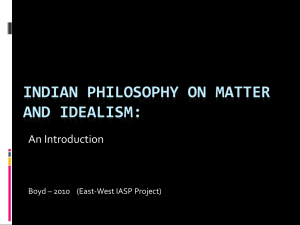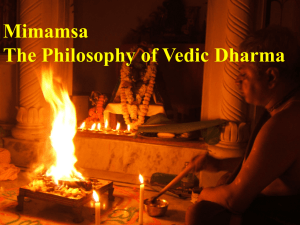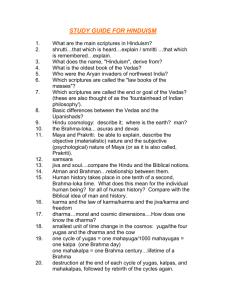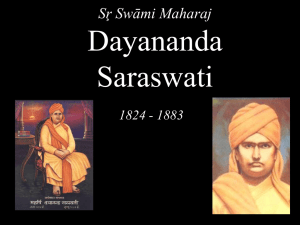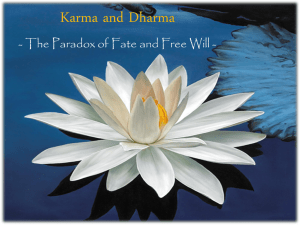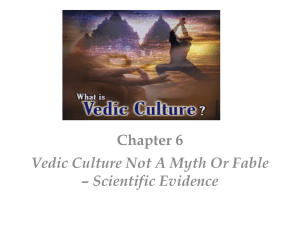Shankara at Badari
advertisement
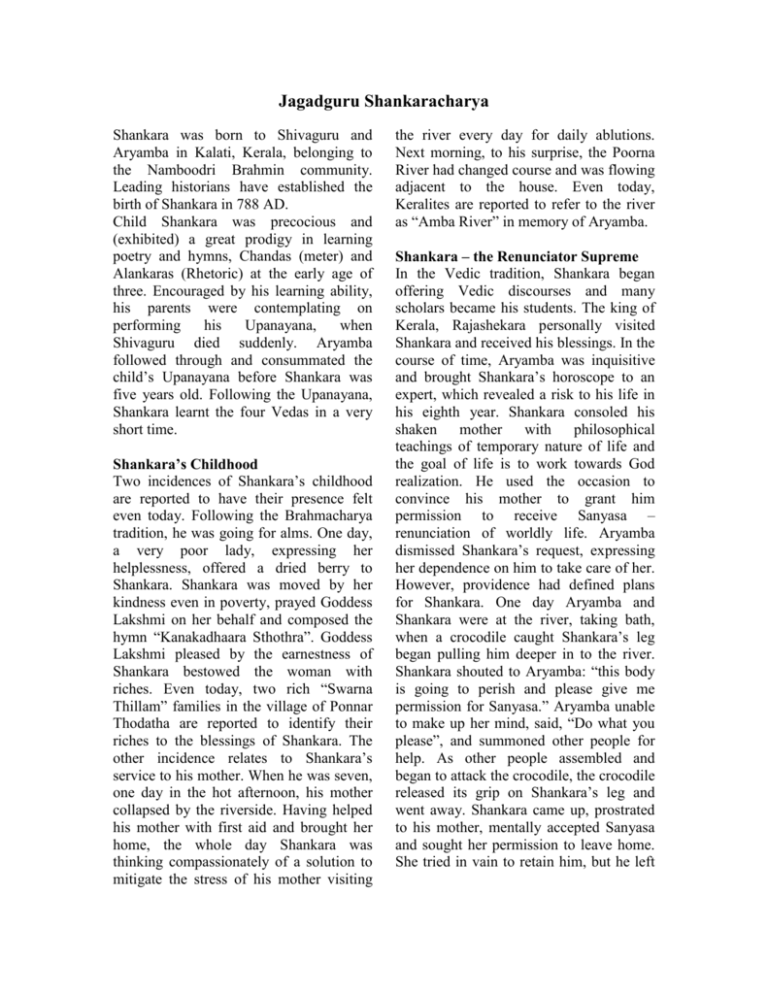
Jagadguru Shankaracharya Shankara was born to Shivaguru and Aryamba in Kalati, Kerala, belonging to the Namboodri Brahmin community. Leading historians have established the birth of Shankara in 788 AD. Child Shankara was precocious and (exhibited) a great prodigy in learning poetry and hymns, Chandas (meter) and Alankaras (Rhetoric) at the early age of three. Encouraged by his learning ability, his parents were contemplating on performing his Upanayana, when Shivaguru died suddenly. Aryamba followed through and consummated the child’s Upanayana before Shankara was five years old. Following the Upanayana, Shankara learnt the four Vedas in a very short time. Shankara’s Childhood Two incidences of Shankara’s childhood are reported to have their presence felt even today. Following the Brahmacharya tradition, he was going for alms. One day, a very poor lady, expressing her helplessness, offered a dried berry to Shankara. Shankara was moved by her kindness even in poverty, prayed Goddess Lakshmi on her behalf and composed the hymn “Kanakadhaara Sthothra”. Goddess Lakshmi pleased by the earnestness of Shankara bestowed the woman with riches. Even today, two rich “Swarna Thillam” families in the village of Ponnar Thodatha are reported to identify their riches to the blessings of Shankara. The other incidence relates to Shankara’s service to his mother. When he was seven, one day in the hot afternoon, his mother collapsed by the riverside. Having helped his mother with first aid and brought her home, the whole day Shankara was thinking compassionately of a solution to mitigate the stress of his mother visiting the river every day for daily ablutions. Next morning, to his surprise, the Poorna River had changed course and was flowing adjacent to the house. Even today, Keralites are reported to refer to the river as “Amba River” in memory of Aryamba. Shankara – the Renunciator Supreme In the Vedic tradition, Shankara began offering Vedic discourses and many scholars became his students. The king of Kerala, Rajashekara personally visited Shankara and received his blessings. In the course of time, Aryamba was inquisitive and brought Shankara’s horoscope to an expert, which revealed a risk to his life in his eighth year. Shankara consoled his shaken mother with philosophical teachings of temporary nature of life and the goal of life is to work towards God realization. He used the occasion to convince his mother to grant him permission to receive Sanyasa – renunciation of worldly life. Aryamba dismissed Shankara’s request, expressing her dependence on him to take care of her. However, providence had defined plans for Shankara. One day Aryamba and Shankara were at the river, taking bath, when a crocodile caught Shankara’s leg began pulling him deeper in to the river. Shankara shouted to Aryamba: “this body is going to perish and please give me permission for Sanyasa.” Aryamba unable to make up her mind, said, “Do what you please”, and summoned other people for help. As other people assembled and began to attack the crocodile, the crocodile released its grip on Shankara’s leg and went away. Shankara came up, prostrated to his mother, mentally accepted Sanyasa and sought her permission to leave home. She tried in vain to retain him, but he left home with a promise to his mother that he would come back at the time of her death. Shankara became Shankaracharya (Acharya means learned teacher). Guru Darshana (Meeting the Teacher) Shankara’s renunciation at such a young age and his knowledge of the Vedas promoted promoting the belief that he was an incarnation of Lord Shiva. In the footsteps of Krishna going to Saandipany, Shankara went in search of his Guru. After several days of walking, Shankara found his teacher, Govinda Bhagavatpaada in a cave on the banks of the River Narmada. He introduced himself to the Guru, and narrated his mental acceptance of Sanyasa and requested the Guru to formally offer him Sanyasa. Govinda Bhagavatpaada at once recognized the pre-requisites for Sanyasa in the young boy and formally initiated Shankara to Sanyasa, gave him the necessary instructions and advised Shankara to write the commentaries for the Upanishads, Brahma Suthra and Bhagavad Geetha. His commentaries, written later in his life, collectively came to be called as Prasthana Thraya. Thus Receiving Students Shankaracharya traveled to Varanasi (Benares), the seat of Vedic learning. Shankara’s Vedic discourses immensely influenced the people of Varanasi. Several of them enrolled as his students, the most notables ones being Sanandana, who later became Hasthamalaka and Thotakaacharya. It was during one of these days that Shankara composed the Bhaja Govindam” hymn, roused by the citing of an old man wasting his time learning the rules of Grammar (Apara Vidya), instead of focusing his mind in the pursuit of God Realization through devotion to God (Para Vidya). Meeting with Chandala After the Acharya bathed in Ganges one day, while returning with his disciples, a Chandala (keeper of the crematorium-an outcaste) came across them. The students beckoned the Chandala to step aside, but he replied: “What difference do you see in me? You seem to be ignoring the presence of Divinity (Athma Thatva) in every one; instead you are focusing on the body and differentiating between a brahmin and a Chandala.” Smiling, the Acharya intervened; the Chandala engaged Shankara in a deep spiritual discussion on the Advaita (Non-duality) philosophy and lightly chided Shankara. Shankara, recognizing the distinct understanding of Athma (the Real) and Anathma (the unreal) by the Chandala, stared at him and Lord Viswanatha gave his Darshan to Shankara. Shankara prostrated to the Lord in the guise of the Chandala and composed and instantly composed the Manisha Panchaka Sthotram in praise of Viswanatha. Shankara at Badari Shankara traveled to Badari. At the temple, he noticed the absence of a Deity. On inquiry, he learnt that due to Chinese disturbances, the Deity was thrown to the Alakananda River. The Acharya suggested bringing back the idol and installing it at the temple. However, no one was prepared to risk his life by jumping into the ferocious river. Shankara himself jumped into the river and repeatedly pulled out the same broken idol three times, after returning it to the river each time (broken idols are generally not installed in temples). He concluded it was God’s will, brought up the idol and installed it at the temple per Vedic rituals, and appointed the Namboodri Brahmins of Kerala to worship the Deity forever. Even to this day, their family is in charge of worship at the temple. While staying in Badari, Shankara wrote the commentaries for Upanishads, Brahma Suthra and the Bhagavad Gita – Collectively called the Prasthana Thraya, at the Vyasa Ashram, where Vyasa wrote the Mahabharatha. Shankara’s age was 16 years by now. Meeting Kumarilla Bhattapaada One day Shankara was teaching his pupils the Prasthana Thraya when an old man appeared and began to challenge Shankara on his commentaries. During the course of the discussions, Shankara recognized he was none other than Veda Vyasa and prostrated to him. He blessed Shankara that his commentaries be the fountain of knowledge for seekers for centuries to come and instructed Shankara to meet Kumarilla Bhattapada in Prayag (which is now Allahabad). Bhattapada was a learned scholar and during his time, the Buddhist religion was very strong and was hostile to the Vedic religion – Sanathana Dharma (which is now referred to as Hinduism). The Vedas are broadly categorized in to two sections – The Gnana Kaanda (section on Knowledge or pure consciousness) and the Karma Kaanda (Section on sacrifices and rituals). Though both the sections are Apouresheya – no human author and given by Lord Narayana at the beginning of the Kalpa, the Gnana Kaanda could be defended on the basis of logic, but the Karma Kaanda had to be accepted as is, because of being Apoureshaya. This created an opening for the Buddhists to bad mouth the Vedas and hence the Hinduism. Kumarilla Bhattapaada, a very well trained Vedic scholar was defending the Vedas and got a strong desire to once and for all, defend the Vedic Dharma from the onslaught of Buddhism. In order to successfully do this, he needed to thoroughly understand Buddhism and so he took to the study of Buddhism in disguise under a Buddhist monk. Over the course of time, one day, Bhattapaada could not control his emotions at the criticism of Vedas by the Monk and tears flowed from his eyes. The other Buddhist students suspected him to be a Brahmin and confronted him. Kumarilla Bhattapaada had to leave the monastery, though by this time, he had learnt Buddhism very well and was able to successfully defend the Vedas and exposed the weakness of Buddhism. Though Bhattapaada was successful in his mission, he felt within him, the guilt of exposing his teacher’s Dharma, and more so, learning from him in disguise. He sentenced himself for his sin - slow death by burning. So he immersed himself in a huge heap of burning paddy husk. It was at this precise time, Shankara came to see him. Shankara could not convince him that he did not commit a sin and that he did not deserve this punishment. Shankara told him that he needs him to write a treatise on his Prasthana Thraya and asked him to come out. Bhattapaada rejected Shankara’s request, asked him to meet his very learned student Mandana Mishra. He assured Shankara that Mandana Mishra would be immensely helpful to him in the propagation of Vedic Dharma and closed his eyes. Mandana Mishra Mandana Mishra was a leading champion of Vedic Karma Kaanda. Shankara’s goal was to establish the role of Gnaana Kanda in itself and in support of Karma Kaanda. His thesis was that Karma, without the support of Gnaana, would over time reduce Karma to blind rituals and would cause people to lose confidence in the Vedic tradition. So, Shankara believed that if the great Karma proponent like Mandana could perceive the value of Gnaana as a complement to Karma, the Vedic tradition would survive any confrontation. With this thought, Shankara came to the town of Mahishmathi in search of Mandana Mishra. After inquiry, he came to the doorsteps of Mandana. Mandana was in the midst of a ritual and did not quite appreciate the intrusion by a young sanyasi. Mandana displayed his hostility, which Shankara turned back at him in satire. The other Brahmins at the place, recognizing Shankara’s intellect, encouraged Mandana to offer Biksha (alms) to the young sanyasi. Shankara suggested that he could accept alms only if Mandana would debate him on the Vedic Dharma. Mandana Mishra accepted the offer. His wife, Ubhaya Bharathi Devi was named the judge and the debate began the next morning. Shankara began the debate with the following declaration; “Brahman is the only Supreme Reality. The Jiva – the soul in every living being – ignorant of the presence of the Supreme Reality in him, has developed this duality – that the Jiva and the Supreme Reality are two different entities”. This dual identity, Shankara asserts, is the basis of all karma. Right Knowledge (gnana) of the presence of this Reality (Athman, Brahman, Supreme Reality are all synonyms) will erase all actions. [Karma can take place in duality only – someone or something acting on something else: if this duality does not exist, karma cannot sustain and so is erased, because the doer and the receiver are one and the same] This is the Advaita Siddhantha (Non-dual philosophy) expounded by Shankara. He argued that this is the essence of the Gnaana Kaanda of the Vedas. “If I fail to establish this Reality to the satisfaction of Mandana Mishra,” Shankara declared, “I will give up sanyasa and wear white clothes.” Mandana Mishra replied; “ Veda suggests Karma. The Jiva is bound by Karma and the realization (Moksha) is a result of Karma.” If I fail to prove this philosophy, he declared, “I will become a sanyasi and wear Ocher colored clothes.” The debate began and lasted several days. Over the days, Shankara was successful in convincing Mandana and establishing that the Vedas proclaim the Reality – Gnaana culminates in Moksha or God realization. The debate concluded with Mandana Mishra prostrating at the feet of Shankara. Mandana’s life long devotion to selfless karma paved the way to appreciate Shankara’s logic and destroyed the belief of duality in Mandana. With Realization, there was no more karma and no more debate (talking is also one of the actions). Though Shankara was not surprised, the defeat of Mandana came as a total surprise to everyone assembled there, more so to Ubhaya Bharathi Devi. The defeat of her husband and the prospect of Mandana following young Shankara as a sanyasi extremely disturbed her. She challenged Shankara that he would have to defeat her in debate to take her husband with him (she argued that being the wife of Mandana, she has an obligation to defend him). Shankara, without anticipating the risk, agreed to her challenge. As Shankara successfully responded to her questions, her desire to defeat him and stop her husband from following him grew more intensely in her. This motivated her to question Shankara on the intimate moments between a man and his wife. Shankara at 17 now, and a sanyasi from the age of eight (8), was almost overwhelmed at the turn of events and sat silently for a while. He paced the room, without a clear direction for his next move. He was convinced that it was imperative for him to take Mandana Mishra with him. The success of Kumarilla over the Buddhists had created tremendous faith in people on the Karma Kaanda of the Vedas and a parallel faith in the Gnana Kaanda was absolutely necessary to arrest Karma Kaanda from degenerating to mere rituals. Mandana Mishra, the unparalleled king of Karma Kaanda, accepting Gnaana Kaanda and taking sanyasa would have a tremendous positive impact on such a goal. With this firm determination, Shankara returned to the assembly; he requested and received a month’s time from Ubhaya Bharathi to answer her question and left the place. Parakaya Pravesha Shankara was in deep thought and absolute silence as he and his disciples walked through the forests and reached the town of Amrithapura. The town was mourning the death of its king Amaruka. The disciples noticed a sudden change in the expression on the face of Shankara. Shankara took them to a solitary place and resolutely said; “he will enter the dead body of king Amaruka through the power of Yoga (Parakaya Pravesha), learn the answers to the questions of Ubhaya Bharati and return and instructed them protect his body very carefully in a cave until he returns.” The disciples were speechless for a while. They questioned him on the need for such a radical action as well as its impact on his sanyasa dharma. Shankara responded that finding the answers would pave the way for Mandana Mishra becoming a sanyasi, which is necessary for the spiritual growth and welfare of people for centuries to come. The society would run the risk of losing faith in the Vedas and non-Vedic religions will overtake the Vedic dharma, he argued. “Mandana Mishra, the champion of Karma Kaanda, accepting and following the Gnana Kaanda will influence the society in the right path. This is the greatest value of taking Mandana Mishra as a sanyasi with us. The sin of Parakaaya Pravesha will dwarf in comparison with the benefit to society.” Shankara rejected the disciples’ suggestion of gaining the knowledge by reading books for two reasons – 1) it is not a direct knowledge and 2) reading such material in the body of a sanyasi is also equally objectionable to sanyasa dharma. He was convinced of the need to answer Bharathi Devi and take Mandana Mishra with him as a sanyasi in the interest of preserving the Vedic Dharma for centuries to come. He asked his disciples to protect his body in the cave. He left his body and entered the body of the king. As Shankara was learning all he need to learn to answer Ubhaya Bharati Devi, the palace officials suspected a yogi in the body of the king. To save their king this time, they ordered all dead bodies to be cremated. Shankara returned in time and entered his body again. As he went to meet Ubhaya Bharati Devi, she did not press him for an answer and Shankara was spared of discussing this subject as a sanyasi. She did not object to taking Mandana Mishra with him. Mandana joined Shankara as a disciple in the name of Sureshwaracharya, and became the head of Shringeri Mutt. Meeting Mother Again Shankara at once got a strong desire to see his mother. He traveled to Kalati. As he reached Kalati, she was in deathbed. She was very happy to see her son come back as he had promised earlier. Shankara assured her that her pious life would earn her Vishnupaada and will achieve Moksha. Aryamba peacefully closed her eyes. Shankara was overtaken by emotion as he recalled her hard life to bring him up after his father’s death. He collected himself, cremated the remains of his mother and left Kalati again. Establishment of Dharma – Public Welfare Shankara Bhagavathpaada had already laid the foundation for the establishment of Dharma with his work so far. He took up the job of permanent and firm fixture of Dharma. He set out from the south to travel the entire country again. As he traveled, he reformed people of several faiths, including the Pashupatha (variation of Shaivites), Soura (followers of Sun god), and Kaapalika (variation of Shaivites). He visited places including Rameshwara, Madurai, Sriranga, Kaanchi, and Thirupathi. In Kanchi, he reformed the Tantrik faith followers (followers of Thamasic worship) and reformed them to Sathvic followers. In Ujjain, he reformed many of the Buddhist and Jain faiths and helped them back to the Vedic Dharma. In the Pashupathi Natha temple in Khatmandu, Nepal, he helped stop the sacrifice of animals and reformed the worship to Sathvic worship. As the people of the country were followers of one of the following six faiths – Shaiva, Vaishnava, Shaktheya (worshipping Shakthi or Devi), Soura (worshipping Sun), Ganapathya (Worshipping Ganapathi) or Kaapalika, he brought them all under the umbrella of Vedic faith, eliminating mutual distrust of each other. He is therefore called the Shanmatha-Sthaapana-acharya (establisher of six-faith dharma). Sarvagna Peeta in Kashmir Shankara by this time had established the sovereignty of the Vedic dharma and the atheist faith had faded. Now Shankara had to take steps to assure its stability for the next several generations to come. He concluded that the Sarvagna Peeta – Seat of Omniscient – in Kashmir would provide the seal of authority for the continued propagation of the Vedic dharma. He arrived in Kashmir. He debated and defended the Vedic dharma among the local and assembled pundits. He overcame all challenges and was ordained to the Sarvagna Peeta. Shankara’s programs from this position helped restore the Vedic Advaita following for several generations. To further solidify this order, Shankara established Mutts (monasteries) in the four directions of the country as follows; Direction City East South Puri Shringeri Branch of Acharya Veda Rigveda Padmapaada Yajurveda Sureshwara West Dwaraka Samaveda North Badari Atharvanave da He promoted Panchaayathana Puja (Five Deity worship) to foster cooperation and equality among the worshippers of Shiva, Vishnu, Aadithya (Sun), Ambika (Devi) and Gananatha. Under the program, everyone will worship all these deities, with their deity at the center, surrounded by the four other deities. His works – Prasthana Thraya for intellects and innumerable hymns for ordinary people – paved the way for spiritual progress. He helped people develop faith in Vedas, Vedantha and Puranas at the same time. At the age of 32, overseeing all these works, and convinced of the longevity and preservation of the faith, Shankara entered the cave in the Dathatreya temple in Kedarnath (in the Himalayas), 2000 miles from his birthplace of Kalati, and disappeared. It is the firm belief that Shankara was none other than Lord Shiva, who incarnates to uphold Dharma and arrange people’s lives to be guided within the framework of Dharma. Thus is the biography of Shankara, who mastered the four vedas at age 8, all Shastras at age 12, wrote the commentaries – Prasthana Thraya – at age 16 and left the scene at age 32. Shubamasthu Hasthaamala ka Thotaka Deity Vimala Devi Sharada Devi Name of Peeta Shakti Peeta Sharada Peeta Mahakali Peeta Aamurtha Peeta
